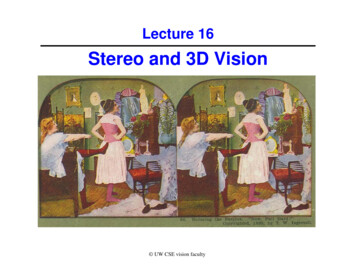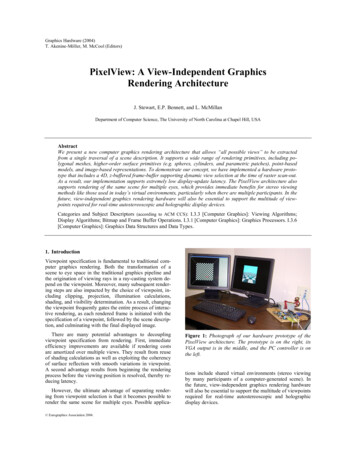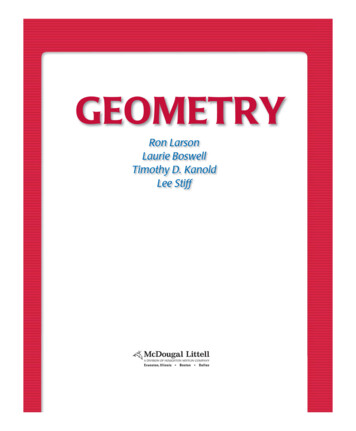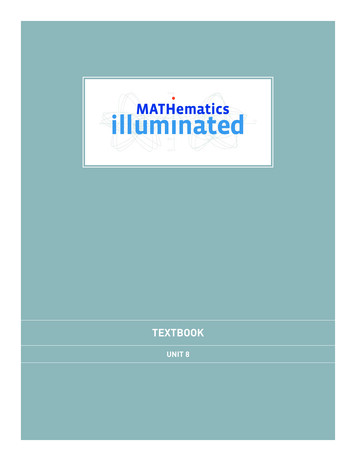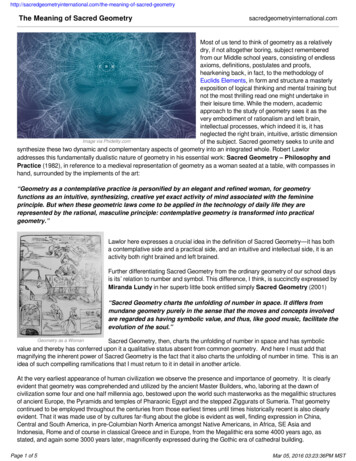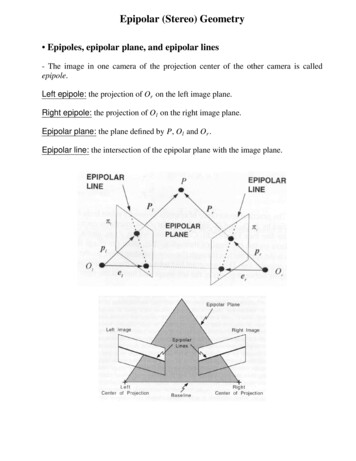
Transcription
Epipolar (Stereo) Geometry Epipoles, epipolar plane, and epipolar lines- The image in one camera of the projection center of the other camera is calledepipole.Left epipole: the projection of O r on the left image plane.Right epipole: the projection of O l on the right image plane.Epipolar plane: the plane defined by P, O l and O r .Epipolar line: the intersection of the epipolar plane with the image plane.
-2Note: if the line through the centers of projection is parallel to one of the imageplanes, the corresponding epipole is at infinity.
-3- Stereo basics- The camera frames are related by a translation vector T (O r O l ) and a rotationmatrix R.- The relation between P l and P r (projection of P in the left and right frames) isgiven byP r R(P l T )- The usual equations of perspective projection define the relation between 3D pointsand their projections:pl flPl ,Zlpr frPrZr Epipolar constraint- Given pl , P can lie anywhere on the ray from O l through pl .- The image of this ray in the right image image is the epipolar line through the corresponding point pr .Epipolar constraint: "the correct match must lie on the epipolar line".- Establishes a mapping between points in the left image and lines in the right imageand vice versa.Property: all epipolar lines go through the camera’s epipole.
-4- Importance of the epipolar constraint- Corresponding points must lie on conjugate epipolar lines.- The search for correspondences is reduced to a 1D problem.- Very effective in rejecting false matches due to occlusion (how?) Ordering- Conjugate points along corresponding epipolar lines have the same order in eachimage.- Exception: corresponding points may not have the same order if they lie on the sameepipolar plane and imaged from different sides.
-5-Estimating the epipolar geometry- How to estimate the mapping between points in one image and epipolar lines in theother? The essential matrix, E- The equation of the epipolar plane is given by the following coplanarity condition(assuming that the world coordinate system is aligned with the left camera):(P l T )T (T x P l ) 0PPP -TOT O - O lOr- Using P r R(P l T ) we have:(RT P r )T T x P l 0- Expressing cross product as matrix multiplication we have:(R P r ) SP l 0TTor P r RSP l 0 whereT 0S Tz T y T z0Tx(the matrix S is always rank deficient, i.e., rank(S) 2)Ty T x 0
-6- The above equation can now be rewritten as follows:PTr EPl 0or pTr Epl 0where E RS is called the essential matrix.- The equation pTr Epl 0 defines a mapping between points and epipolar lines.- Properties of the essential matrix:(1) encodes info on the extrinsic parameters only(2) has rank 2(3) its two nonzero singular values are equal The fundamental matrix, F- Suppose that M l and M r are the matrices of the intrinsic parameters of the left andright camera, then the pixel coordinates pl and pr of pl and pr are:pl M l pl ,pr M r pr- Using the above equations and pTr Epl 0 we have:pTr Fpl 0where F (M r 1)T EM l 1 (M r 1)T RSM l 1 is called the fundamental matrix.- Properties of the fundamental matrix:(1) encodes info on both the extrinsic and intrinsic parameters(2) has rank 2
-7- Computing F (or E): the eight-point algorithm- We can reconstruct the epipolar geometry by estimating the fundamental matrixfrom point correspondences only (with no information at all on the extrinsic or intrinsic camera parameters!!).- Each correspondence leads to a homogeneous equation of the form:pTr F pl 0 orx l x r f11 x l y r f21 x l f31 y l x r f12 y l y r f22 y l f32 x r f13 y r f23 f33 0- We can determine the entries of the matrix F (up to an unknown scale factor) byestablishing n 8 correspondences:Ax 0- It turns out that A is rank deficient (i.e., rank( A) 8); the solution is unique up to ascale factor (i.e., proportional to the last column of V where A UDV T ).Input: n correspondences with n 8Algorithm1. Construct homogeneous system Ax 0 where A is an nx9 matrix. SupposeA UDV T is its SVD.2. The entries of F are proportional to the components of the last column of V .Enforcing the constraint rank(F) 2: (singularity constraint)3. compute the SVD of FF U F D F V FT4. Set the smallest singular value equal to 0; Let D′F be the corrected matrix.5. The corrected estimate of F, F′, is given byF′ U F D′F V FT
-8Important: we need to normalize the coordinates of the corresponding points, otherwise, A has a very bad condition number which leads to numerical instabilities (seep156).
-9- Homogeneous (projective) representation of lines (see Appendix A.4)- A line ax by c 0 is represented by the homogeneous vector below (projectiveline): a b c a - Any vector k b represents the same line. c - Only the ratio of the homogoneous line coordinates is significant:* lines can be specified by 2 parameters only (e.g., slope/intercept):y mx i* rewrite ax by c 0 in the slope/intercept form:y a * homogenization rule for lines: b : c acx bb a/b c/b - Some properties involving points and lines:(1) The point x lies on the line iff x T l 0(2) Two points define a line: l p x q(3) Two lines define a point: p l x mDuality: in homogeneous (projective) coordinates, points and lines are dual (we caninterchange their roles).
-10Example1: (0,-1) lies on 2x y 1 0 0 The point (0,-1) is represented by x 1 1 2 The line 2x y 1 0 is represented by l 1 1 x T l 0. 2 ( 1).1 1. 1 0Example2: find the intersection of x 1 and y 1 1 The line x 1 is equivalent to 1x 1 0 or l 0 1 0 The line y 1 is equivalent to 1y 1 0 or l′ 1 1 The intersection point x isj k 1 ix l x l′ 1 0 1 1 0 1 1 1
-11Example3: find the intersection of x 1 and x 10 (parallel) 1 The line x 1 is equivalent to 1x 1 0 or l 0 1 1 The line x 10 is equivalent to 1x 10 0 or l′ 0 10 The intersection point x isj k 0 i x l x l′ 1 0 1 9 1 0 10 0
-12- Finding the epipolar lines- The equation below defines a mapping between points and epipolar lines:pTr Fpl 0Case 1: right epipolar line urthe right epipolar line is represented by ur F plpr lies on ur , that is, pTr ur 0 or pTr Fpl 0Case 2: left epipolar line u lpTr Fpl 0 is equivalent to pTl FT pr 0the left epipolar line is represented by u l F T prpl lies on u l , that is, pTl u l 0 or pTl FT pr 0
-13- Locating the epipoles from F (or E)Case 1: locate elel lies on all epipolar lines in the left image, thus, it satisfies the equation:eTl u l 0oruTl el 0or pTr Fel 0which leads to the following homogeneous system:Fel 0We can obtain el by solving the above homogeneous system (the solution el isproportional to the last column of V of the SVD of F).Case 2: locate erer lies on all epipolar lines in the right image, thus, it satisfies the equation:eTr ur 0oreTr F pl 0 or pTl FTer 0which leads to the following homogeneous system:FTer 0The solution is proportional to the last column of V of the SVD of F T (i.e., sameas the last column of U of the SVD of F).F T VDU T
-14- Rectification- This is a tranformation of each image such that pairs of conjugate epipolar linesbecome collinear and parallel to the horizontal axis.- Searching for corresponding points becomes much simpler for the case of rectifiedimages:to find the point corresponding to (i l, j l ) in the left image,we just need to look along the scanline j j l in the right image- Disparities between the images are in the x-direction only (no y disparity)
-15-- Main steps (assuming knowledge of the extrinsic/intrinsic parameters):(1) Rotate the left camera so that the epipolar lines become parallel to the horizontal axis (epipole is mapped to infinity).(2) Apply the same rotation to the right camera to recover the original geometry.(3) Rotate the right camera by R
-16- Let’s consider step (1) (the rest are straightforward):We will construct a coordinate system (e1, e2, e3) centered at O l .Aligning the axes of this coordinate system with the axes of the image planecoordinate system yields the desired rotation matrix.(1.1) e1 is a unit vector along the vector TT e1 T [T x , T y, T z ]TT x2 T y2 T z2 (1.2) e2 is chosen as the cross product of e1 and the z axise1 x [0, 0,1]Te2 e1 x z 1T x2 T y2 [ T y, T x , 0]T(1.3) choose e3 as the cross product of e1 and e2e3 e1 x e2- The rotation matrix that maps the epipoles to infinity is: R rect e1T e2T T e3 - Note: rectification can also be done without knowledge of the extrinsic/intrinsicparameters (more complicated).fixation pointzzoptical axisoptical axisyxyorolx2Ol31elerOr
-Giv e n pl, P can lie anywhere on the ray from Ol through pl.-The image of this ray in the right image image is the epipolar line through the corre-sponding point pr. Epipolar constraint: "the correct match must lie on the epipolar line".-Establishes amapping between points in the left image and lines in the right image and vice versa.
